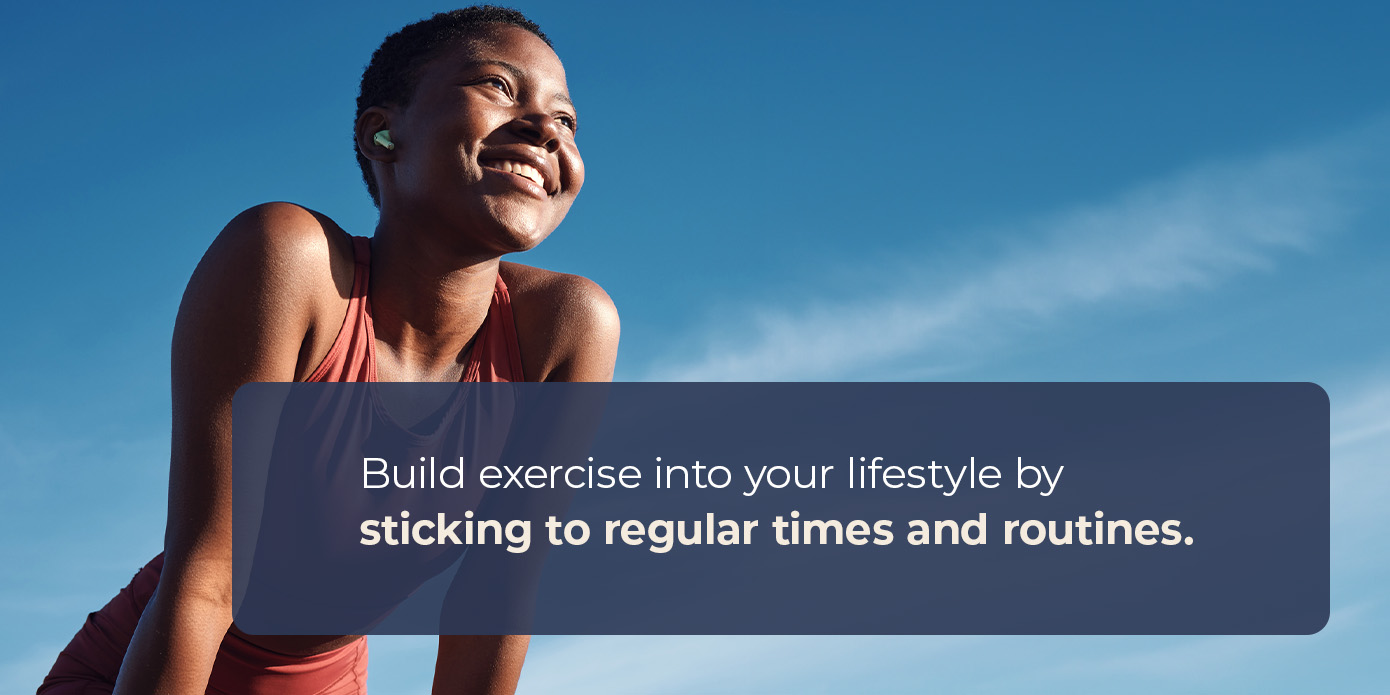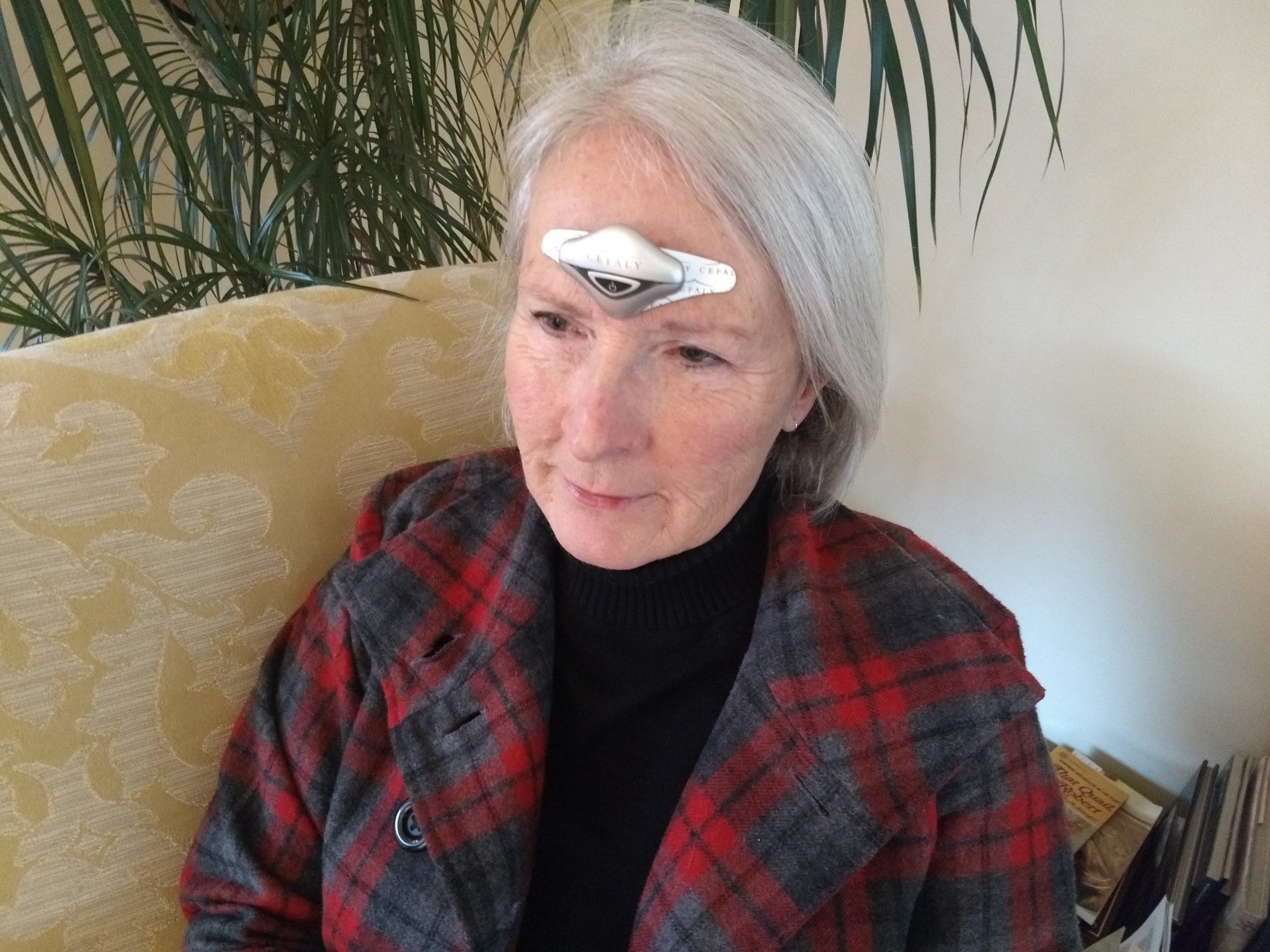- Why exercise can trigger migraine episodes
- How to prevent exercise-induced migraine
- Finding the right balance between exercise and migraine
- How to get rid of exercise-induced migraine
- Exercises to try
You’ve probably heard that regular exercise can benefit people with migraine. However, some people find working out activates migraine attacks instead of easing them. About two-thirds of people with migraine report pain aggravation through routine physical activity.
Experiencing a pounding headache or other debilitating symptoms after your workout can be frustrating, leading many to ask, “Why do I get migraine after a workout?” Exercise and migraine have a complicated relationship, and the risk of migraine attacks can erase your motivation to stay fit.
You can prevent migraine attacks after exercise by prioritizing hydration, warming up and cooling down properly, and listening to your body and stopping if you experience any symptoms. Understanding you individual triggers and underlying factors can help you take steps to prevent post-exertional migraine and keep your fitness routine enjoyable.
Why does exercise trigger migraine attacks?
Experiencing migraine after exercise is common for many people. The exact cause is unclear, but several likely culprits exist. Quick movements, like sudden neck and shoulder jerks or bending to lift weights, can exacerbate migraine symptoms. A combination of triggers likely causes migraine after working out, such as:
- Metabolic challenges: Vigorous exercise is metabolically demanding. Fasting also challenges the metabolism. Both are common migraine triggers. Exercise causes your blood sugar levels to drop, which can bring on an attack, especially if you forget to eat beforehand.
- Exercise environment: Where you exercise can be a migraine trigger. For example, exercise-induced migraine attacks are more likely when you work out in the heat, humidity or high altitudes.
- Sudden routine changes: Any abrupt changes in your routine can bring about a migraine attack, such as exercising without proper planning or a warmup. Starting a strenuous exercise program alongside a new diet is another example.
- Dehydration: Your body needs extra water and electrolytes during exercise. You lose fluids and electrolytes through sweat. Dehydration sets in — a common migraine trigger.
- Overexertion: Your heart rate increases when you exercise. The blood vessels in your body dilate to circulate blood and oxygen through your system. For some people, this dilation can cause migraine.
Exercise is one of many possible migraine triggers. Working out in conjunction with other triggers increases the likelihood of a migraine attack. Typical things that might activate a migraine include:
- Stress
- Lack of sleep
- Bright lights or loud noises
- Caffeine, alcohol, preservatives and sweeteners
Finding the right balance between exercise and migraine
If you want to get your daily sweat in but are set back by the thought of triggering a migraine attack, don’t worry. You can still enjoy a workout by finding the right balance. We have three tips to help prevent migraine after workouts.
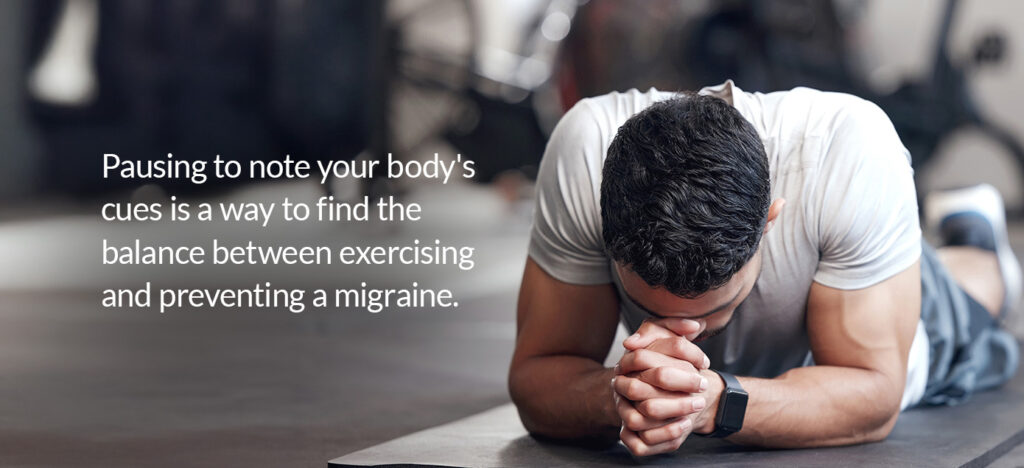
1. Listen to your body
It’s important to listen to what your body’s telling you. For instance, your mind might be telling you you’re “in the zone,” but your body is showing signs of migraine onset. In this case, it’s best to recognize your personal limits and symptoms. Just because you need a break every now and then doesn’t mean you can’t enjoy the benefits of regular workouts. Pausing to note your body’s cues is a way to find the balance between exercising and preventing a migraine.
To help you monitor how your exercise routine affects your migraine patterns, consider keeping a migraine diary to log every detail of your exercise-induced migraine. Here’s what you can track:
- Migraine duration, frequency and intensity
- Exercise type, duration and intensity
- Hydration and nutrition intake
- Sleep amount
- Triggers and symptoms experienced
- Characteristics of the environment you’re exercising in, like light and noise levels
2. Create an adaptable exercise plan
Migraine is complex and can appear at unforeseen times, sometimes before, during or after exercising. To find balance, try creating an adaptable schedule that accommodates the onset of a migraine attack with these tips:
- Assess your fitness level: Know your current fitness levels and consider any limitations.
- Set realistic goals: Be realistic about how migraine might affect your exercise goals. Aim for gradual progress over duration or intensity.
- Include rest and recovery days: Consistency plays a role in any workout plan, but so does getting enough rest. Sleep is important for exercising and migraine management.
- Monitor your response: Note any migraine symptoms during or after each workout in your diary. Use these insights to adjust your workout plan.
- Talk with a professional: Consult with your healthcare provider regarding any concerns about your workout routine and migraine. They may provide additional tips.
- Be flexible and patient: Know that some days may be better than others. You don’t have to follow your exercise routine precisely for you to be successful. Be flexible and listen to your body.
Get Drug-Free Migraine Relief With CEFALY
Shop Now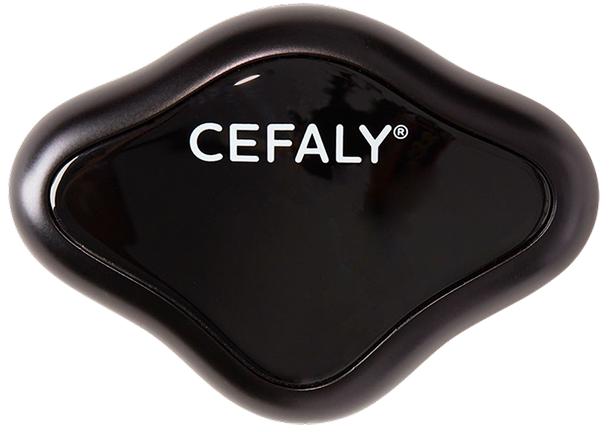
90-day money back guarantee
FDA-cleared
financing available
3. Identify safe exercise windows
Your migraine diary will be useful for identifying safe exercise windows. Each workout and exercise-induced migraine you track makes it easier to find these windows of opportunity. Use these times to make the most of your workout while preventing a migraine. Just remember to be flexible with your schedule to avoid working out during a migraine attack or aura.
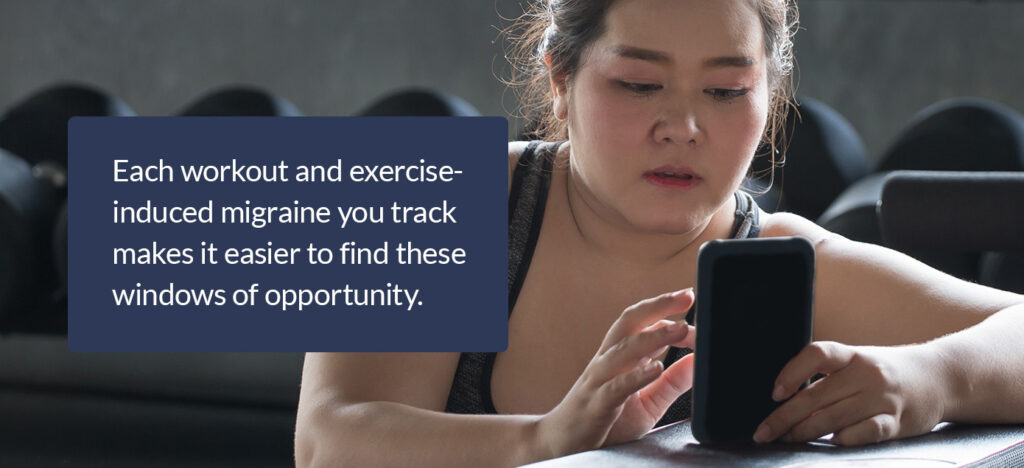
Practical tips for exercising with migraine
To help prevent migraine after a workout, consider these practical tips:
1. Drink water: Hydration is important for exercising and preventing migraine. Ensure you drink enough before, during and after working out.
2. Eat first: Try eating a small nutritious snack before exercising to fuel your body and maintain your blood glucose levels. Avoid fasting before workouts if hunger is a trigger for your symptoms.
3. Warm up before: Take a few minutes to warm your body up and ease it into the workout itself. Using CEFALY’s PREVENT mode before may also further prevent migraine.
4. Cool down after: After exercising, stretch your muscles and relax to cool down your body. You can also use CEFALY afterward as an extra preventive measure — or use the ACUTE mode at the first sign of an attack.
5. Be mindful during: As you’re exercising, listen to your body. If you feel any symptoms like dizziness, nausea, discomfort or pain, stop. Note such instances in your migraine diary.
6. Avoid overexertion: Take it step-by-step. Gradually increase your workout’s duration and intensity.
How do I prevent exercise-induced migraine?
You can take preventive measures to avoid migraine triggers and keep attacks at bay. The following tips can help.
1. Consider your environment
Exercising outdoors is excellent for your physical and mental wellness, but you can experience an attack if you get too hot. If you prefer to exercise indoors, keep the environment cool and dry whenever possible. Sensory overload can become a challenge for indoor workouts. For example, you may have to contend with loud music and bright overhead lights in a gym. Be aware of areas with music blasting and weights clanking. Noise-canceling headphones can help.

2. Stay hydrated
Proper hydration is essential for good migraine management. Drink plenty of water before, during and after exercise to avoid dehydration.
3. Limit caffeine
Many workout supplements contain caffeine to boost your performance during exercise. As caffeine is a known trigger, avoid these supplements or look for caffeine-free options.
4. Practice good sleep hygiene
Lack of sleep is a known migraine trigger. Focus on your sleep routine and avoid heavy exercise after a poor night’s sleep.
5. Choose the right type of exercise
Strenuous, fast-paced exercise increases the likelihood of a migraine attack. Low-impact movement is an excellent place to start a workout regimen. Try different activities to find something you enjoy. Begin with walking, cycling, swimming, yoga or cycling, adding more challenging activities as you progress.
6. Build up slowly
Start with a comfortable activity level and gradually build on it, going one step at a time to avoid sudden changes and overexertion. Keep sessions short and increase your workload as your body becomes more accustomed to physical activity.
7. Keep a migraine diary
Track your exercise type and duration alongside your migraine attacks. Use the CeCe Migraine Management app to identify activity and migraine frequency patterns. This information shows you whether a specific form of exercise works for you. You’ll learn what to avoid, which foods you can eat and the effects of sleep on attack frequency, severity and duration.
8. Create an exercise routine
Preparing for exercise is as critical as your workout. Speak to your doctor before starting any new fitness regimen. Remember the following tips for excellent exercise preparation.
- Watch what you eat: Eat a high-protein meal or snack at least an hour before working out. You’ll give your body time to digest and have the energy to power through your routine. Fueling your body prevents significant changes in your blood sugar levels during exercise. Following a strict diet may be tempting if your goal is to lose weight. However, calorie restrictions can be a trigger, and skipping meals is bad for migraine. Instead, eat five or six smaller meals daily to stabilize your blood sugar.
- Wear the correct clothing: Your clothing should be comfortable and appropriate for the workout. Overheating during exercise can trigger an attack. Choose loose-fitting, sweat-wicking materials and check that you have correctly fitted footwear.
- Warm up and cool down: Let your body ease into exercise and return to normal afterward. Take some time to adjust before and after workouts to avoid sudden heart rate fluctuations.
Build exercise into your lifestyle by sticking to regular times and routines. Keep your bedtime and mealtimes as consistent as possible. When your schedule is dependable, you’ll have more visibility into potential triggers.

9. Keep your head and neck steady
Excellent form is crucial for any workout. Avoid sudden movements and be conscious of where you hold tension in your muscles to relieve unnecessary pressure on your head, neck and shoulders.
10. Avoid extreme altitudes
Thinner air means less oxygen. Working out at higher altitudes than you’re used to could trigger an attack. Take it easy for the first few days at a new altitude.
11. Be aware of how migraine medication may affect exercise
Some migraine medications can interfere with exercise, such as beta-blockers. Speak to your doctor about the timing of your medications and establish whether they’re suitable for exercise. You can use drug-free alternatives like CEFALY as part of your migraine management strategy.
How do I get rid of exercise-induced migraine?
Despite your best efforts and preparation, migraine attacks can still occur after exercise. Take the following steps if you experience exercise-induced migraine.
- Stop working out: If you notice migraine symptoms while working out, stop immediately.
- Avoid light: Many people who experience migraine report light as a trigger. Find a dark, quiet place to lie down.
- Take migraine medication: Medication can reduce migraine attack severity. Take your chosen medications as soon as you notice migraine symptoms. Avoid resuming the activity unless your doctor has cleared your meds for use with exercise.
- Hydrate: Drink plenty of fluids. Adding an electrolyte mix to your water can also help balance your blood sugar.
- Relax: Stress is one of the most common self-reported migraine triggers. Practicing post-workout relaxation can help reduce stress. Consider activities that calm you down, like taking a warm bath, listening to soothing music or meditating.
- Grab your migraine toolkit: Many people living with migraine have a kit containing all the essentials they need to alleviate symptoms. Consider an ice pack to bring down your temperature or electrolyte drinks to rehydrate you.
- Use CEFALY: CEFALY is a clinically proven, drug-free migraine treatment and management tool. This wearable device targets the trigeminal nerve — the primary pathway for migraine pain. Use the ACUTE program at the first sign of a migraine attack. You can also use the PREVENT program daily to reduce attacks by desensitizing the trigeminal nerve. In one clinical study, 38.1% of CEFALY users saw at least a 50% reduction in migraine days.
Migraine and exercise FAQs
Let’s answer a few exercise and migraine frequently asked questions.
Is exercise good for migraine?
Though exercise can be a migraine trigger, evidence suggests it can also decrease migraine attacks. A daily workout releases endorphins that act as a natural painkiller, reducing migraine frequency and intensity. Exercise relieves stress and helps you sleep better, combating other typical migraine triggers.
For most people, exercise and a healthy lifestyle are good for migraine management. The trick is to choose the appropriate fitness routine. Pay more attention to how you exercise and what workouts you choose. Think about your migraine triggers and put routines in place to manage them. When you plan, you get more from your workout sessions.
What exercise should I try?
Everyone is different. Some exercises may cause migraine pain for you, but work well for someone else. You can still work out if you find a routine you enjoy and create a reliable routine. It should be something you look forward to, not another source of stress. Here are some starting points for you to try.
- Light cardio: Your heart is a muscle, and it needs to stay strong to pump blood and oxygen through your body. You can get your heart rate up with walking, jogging or swimming, releasing endorphins while building strength. Start well within your comfort zone, like a 30-minute walk. Add more time and intensity as you build stamina.
- Yoga: Yoga does more than move your body. It quiets your mind and relieves stress — both excellent goals for people with migraine. Physically, it releases the tension you store in your neck, back, hips and shoulders. Yoga is also a workout you can perform even on high-pain days. Studies show that yoga reduces migraine frequency, which is life-changing for people with chronic pain. As you get used to this new form of movement, avoid Bikram or hot yoga. Start with yoga nidra, restorative yoga or hatha yoga.
- Tai chi: This body and mind exercise is a gentle way to improve balance and coordination. Tai chi training reduces blood pressure and improves stress levels. It also improves sleep quality and reduces fatigue. Studies show promising results for people with episodic migraine. Like yoga, tai chi can be soothing, making it a fantastic option for high-pain or low-energy days.
- High-intensity interval training (HIIT): HIIT alternates brief, intense stints of high-energy training with low-intensity or rest periods. For example, you might do jumping jacks for 20 seconds and then rest for 10 seconds. It’s also proved effective in reducing migraine pain. However, as it’s a more strenuous exercise, it may only work for some people with migraine. Start slowly and monitor how your body reacts. Working with a qualified trainer is best if you’re new to this form of exercise.

How can I minimize the risk of a migraine when exercising and still lead a healthy lifestyle?
The good news is small lifestyle changes can significantly improve your quality of life. A holistic approach to migraine management often yields positive results.
Focus on avoiding common migraine triggers in your everyday life, like nicotine and stress. Get plenty of fresh air, remove strong fragrances and limit loud noises. Tracking your migraine with the CeCe app gives you valuable insights into your most potent triggers. The more you know about your migraine, the better your quality of life. Instead of causing migraine attacks, exercise can be one of your healthy habits for migraine prevention. Combine regular workouts with balanced meals, hydration and sleep. You may notice you experience fewer migraine days.
Meditation and mindfulness activities can also help with migraine by supporting better sleep and managing stress. Incorporate meditation into your routine. Consider other relaxation strategies like walking outdoors or listening to calming music.
Remember, building new habits takes time. Be kind to yourself and start with minor changes. You can still achieve your goals even if you miss a day. Experiment with different exercises and gradually build your intensity. Soon, you’ll have a routine that works for you.

Manage your migraine with CEFALY today!
You can tackle your migraine challenges with a healthy lifestyle. Everyone experiences migraine differently. You may need to experiment with various routines and treatments to find the perfect fit. Look no further than CEFALY if you prefer drug-free alternatives.
Our mission is to empower people with migraine to take control of their treatment. Our wearable device has been clinically proven to help treat acute migraine attacks and prevent future attacks. In a recent study, 43% of CEFALY users reported resolution of all migraine symptoms following 2 hours of eTNS therapy.
Buy CEFALY today for better migraine management. And you can always contact us with any questions and learn more about our noninvasive migraine solution.

